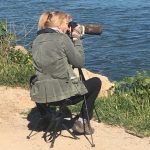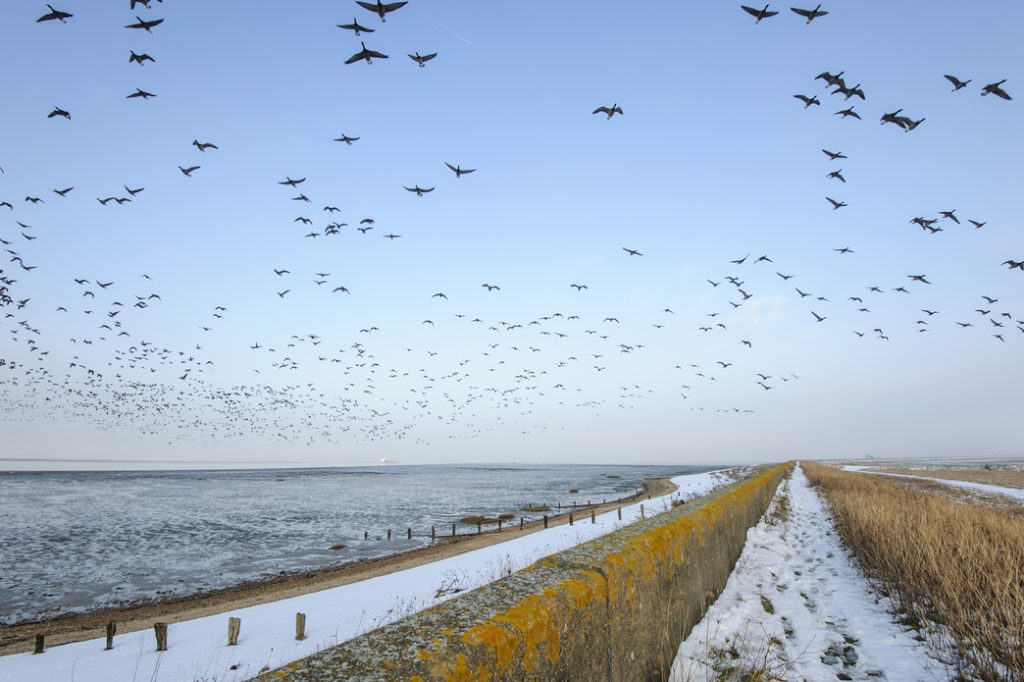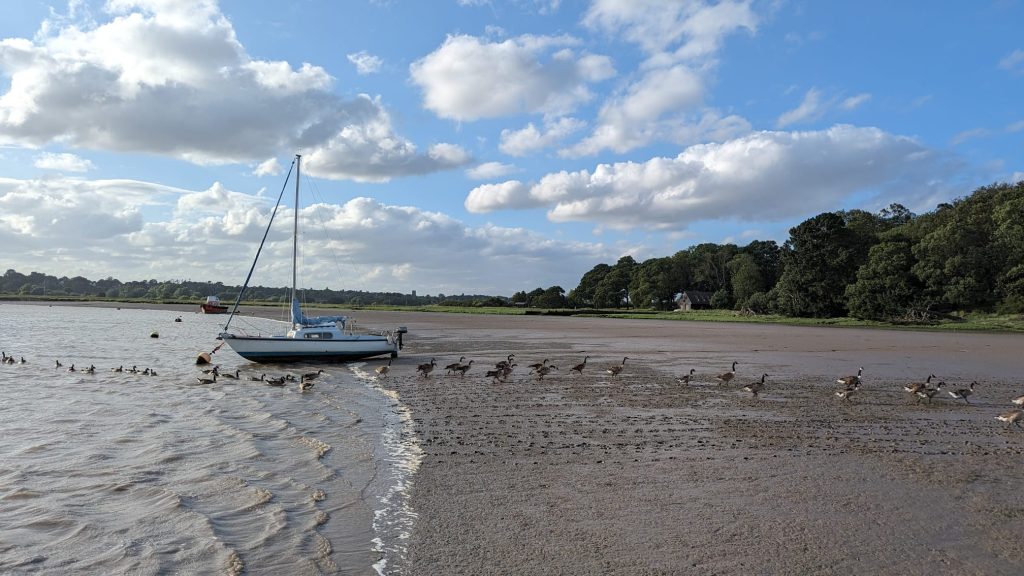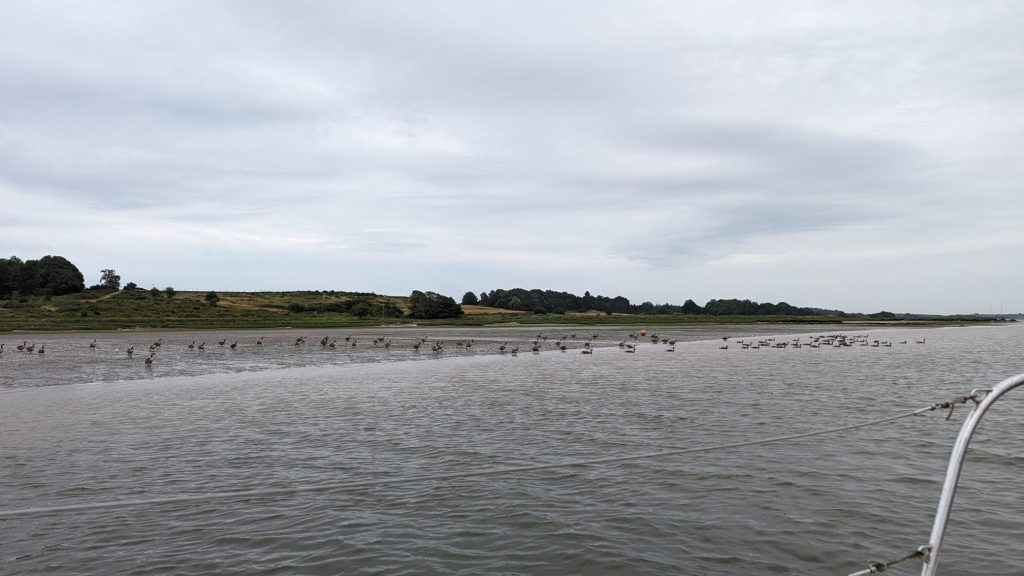By Sally Westwood
Plate 1: Canada Goose
Source: rspb.org.uk (2023)
Canada Goose
You may have observed large flocks, or a gaggle of Canada Geese1 (Branta canadenis) (see Plate 1, below) on the mudflats and surrounding marshland of the Deben. It is the most familiar goose on our river. It is perhaps not surprising that the Deben functions as a habitat for four geese, including the Canada, the Barnacle, the Brent and the Greylag goose, since the Deben and the surrounding marshes and farmland has a wide range of food available for geese. The Deben estuary has narrow mudflats at the mouth of the river and wide mudflats on the inner section of the estuary. The majority of the land to the side of the estuary is agricultural farmland and this is flanked by grazing marshes. The estuary is also heavily fringed by Saltmarsh, as well as small side creeks, the largest of which is Martlesham Creek at the northern end of the river.
Canada Geese are boldly marked, with a black head and neck, brown back and white cheeks2. They usually have a weight of between 4-5kg, and they have a wingspan that ranges from 1.5 to 1.8m3. They mate for life and nest in the same nest, in the same region as their parents4. Males are frequently larger than females5. Canada Geese fly in a V-shaped formation during migration6. This formation occurs because each bird flaps their wings and creates an updraft, lifting the bird flying behind, boosting their flight. Canada Geese may achieve speeds of over 100 kilometres an hour, when there is a strong tail wind. In contrast to other wildfowl, Canada Geese feed on land, for up to twelve hours a day, to ensure sufficient nutrients are obtained. They eat leaves of grass plants and seeds, roots, berries, and stems, and seek out spilled soybeans, oats and corn on farmland.
Canada Geese originate from North America and were introduced in London, over 300 years ago7. They gradually spread across the UK during the 1940s and 1950s. They are distributed throughout the UK, except in northern Scotland. They are present in a variety of habitats, including farmland, gardens, parks, towns, gravel pits freshwater, reservoirs and wetlands8. These birds have a UK breeding population of 54,000 pairs and UK wintering population of 160,000 birds. Plate 2, below, shows a general distribution of the birds in the UK9.
Plate 2: General distribution of Canada Geese in the UK (Green – resident)
Source: rspb.org.uk (2023)
Canada Geese that winter in urban areas, such as green spaces and rooftops in Chicago, America return to riverine and deep water when temperatures drop below a critical level for them. Specifically, ‘the temperature at which increased thermoregulatory costs are incurred to maintain core body temperature’10. It was suggested that the geese that made this move, used it as an energy conserving strategy and as a resource for food. This may be two of the reasons why Canada Geese are present on or near the Deben in the winter time.
Canada Geese are regarded as partial or rather two seasonal migrants11. They fly north and south to take advantage of rich breeding and feeding grounds in the north in summertime, and fly south for milder weather in the winter time. However, many Canada Geese have chosen not to migrate, and others have a shorter migration route, as a consequence of the rise in temperatures across the tundra and arctic regions12. In the UK, Canada Geese have established large breeding colonies and are largely sedentary geese.
Plate 3: Dark-bellied Brent Goose
Source: rspb.org.uk (2023)
Brent Goose
The Brent Goose13 is a much smaller goose to the Canada goose (see Plate 3, below). They are 56 to 61cm in length. It is similar in size to the Mallard14. It is the only goose in the four present on the Deben estuary that does not breed in the UK. There are two races of Brent Goose. The Dark-bellied race breed for two months of the year on the Arctic tundra, in northern Russia, when the weather is at its best. They leave Russia in September and arrive here, in eastern and southern England in huge flocks (see Plate 4, for a distribution of Brent Geese in the UK).
Plate 4: General distribution of Brent Geese in the UK (Blue – winter)
Source: rspb.org.uk (2023)
Brent Geese on the Deben estuary feed on eelgrass and crops in fields to the sides of the river. Brent Geese leave our shores in April (see Plate 5, below) to fly east to Siberia, stopping off along the Baltic coastline to fatten up for the rest of the journey. They arrive at the Arctic tundra in June when the snow is gradually thawing. Whereas, the pale-bellied race of Brent Goose breed in Canada and fly to Ireland. Brent Geese prefer not to fly in a V-formation, like Canada Geese, instead they fly in family groups, or a skein in wavering lines, which may make it easier for identification. When they gather in large flocks prior to migration, they have ‘a continual conversation of ‘ronking’ and ‘cronking’15, perhaps discussing the most suitable time to leave and good feeding sites.
Plate 5: Brent Geese on migration
Source: rspb 2023. Image David Tipling (2020)
Plate 6: Barnacle Goose
Source: rspb.org.uk (2023)
Barnacle Goose
The Barnacle Goose16 is a similar size to Brent Geese (see Table 1 below, for the physical characteristics of the four geese discussed here), with a length of 58-68cm, a weight of 1.7kg and a wingspan of 1.3m17. I have only seen one Barnacle Goose on the mudflats of the Deben, which conforms to the observation of Barnacle Geese recorded by The Wetland Bird Survey and Goose & Swan Monitoring Programme18 (see Table 2, below). It has a cream face, a rounded head, black neck, and a short bill. Similarly to the Canada Goose it has grey and black wings, but unlike the Canada Goose, it has no brown. It feeds on vegetation, including stems, leaves, roots and seeds. The Barnacle Goose is classified as Amber in the Birds of Conservation Concern, and is included in the Red List for endangered Birds19. It over winters in the north west of the UK, rather than our area (see Plate 7, below, for the distribution of the Barnacle Goose in the UK). For example, a large population of Barnacle Geese20 overwinter on the Solway Firth21. However, small flocks of about 1,450 feral Barnacle Geese nest on park lakes and gravel pits22. When on migration to their breeding ground in Greenland, the Barnacle Goose flies in groups, in long straight lines, unlike the wavering lines of the Brent Goose. It is noisy in flight and makes yapping and barks calls.
Plate 7: General distribution of Barnacle Geese in the UK (Green – resident; Blue – winter)
Source: rspb.org.uk (2023)
Plate 8: Greylag Goose
Source: rspb.org.uk (2023)
Greylag Goose
The Greylag Goose23 is an ancestor of domestic geese24. It is the largest of the geese found in this country. It has a length of 76-89cm, a wingspan of 147-180cm and a weight of 2.9 to 2.7kg. These birds have an orange bill and grey plumage and orange25. The Greylag feeds on roots, cereal leaves, grass, and spilled grain26. In recent years, the Greylag has been re-established with the release of birds, frequently mixing with Canada Geese, at reservoirs and lakes have been semi-tame, rather than wild. Whereas, overwintering birds in Scotland are wild Greylag Geese. Like the Barnacle Goose, they are present on the Solway Firth and in Fife at Vane Farm, RSPB nature reserve (see Plate 9, for the distribution of Greylag Geese). A total of 90,000 wild birds migrate to Scotland the UK from their breeding ground in Iceland. A further 140,000 are resident in Scotland and breed there. Like the Barnacle Goose, the Greylag Goose is classified as Amber in the Birds of Conservation Concern, and is included in the Red List for endangered Birds.
Plate 9: General distribution of Greylag Geese in the UK (Green – resident; Blue – winter)
Source: rspb.org.uk (2023)
For ease of comparison, the physical characteristics of the four geese present on the Deben are presented in Table 1, below.
Table 1: Physical characteristics of the geese present on the Deben
| Physical characteristics | Length | Weight | Wingspan | UK wintering population | UK breeding population |
| Brent Goose | 56-61cm | 1.3-1.6 kg | 110-120cm | 105,000 | N/A |
| Canada Goose | 90-110cm | 4.3-5.0 kg | 150-180cm | 160,000 | 54,000 |
| Greylag Goose | 76-89cm | 2.9-3.7 kg | 147-180cm | 510,000 | 47,000 |
| Barnacle Goose | 58-70cm | 1.3-2.2 kg | 132-145cm | 94,000 | 1,450 |
The Wetland Bird Survey and Goose & Swan Monitoring Programme27, has provided a count of the four geese present in the Deben Estuary between 2019 and 2020. Table 2 below, displays the low tide count of these birds.
Table 2: Low tide count of the geese present on the Deben estuary
| Low tide count 2019-2020 | Month peak | Month average |
| Brent Goose (Dark-bellied) | 1849 | 718 |
| Canada Goose | 28 | 8 |
| Greylag Goose | 171 | 95 |
| Barnacle Goose | 1 | 1 |
Trends for resident geese populations, such as those on the Deben demonstrate increases with British Greylag Goose, Canada Goose, Barnacle Goose and Egyptian Goose, have positive trends28 (see Table 3, for the annual peaks of the geese present on the Deben estuary from 2017 to 2020. Figures for Barnacle Goose has not been recorded for this particular count because they are infrequent. This author was fortunate to observe two Egyptian Geese spending time feeding together at the shoreline of the river, over a course of a week, at Melton, in June this year. Table 3 below, shows the annual peaks of the geese present on the Deben estuary.
Table 3: Annual peaks of the geese present on the Deben estuary
| Annual peaks | 2017-2018 | 2018-2019 | 2019-2020 | 2020-2021 | 2021-2022 |
| Brent Goose | 1,015 | 1,772 | 1,171 | 1,052 | 1,519 |
| Canada Goose | 162 | 107 | 49 | 83 | 306 |
| Greylag Goose | 107 | 105 | 156 | 302 | 253 |
| Barnacle Goose | Not recorded | Not recorded | Not recorded | Not recorded | Not recorded |
As a wider perspective, Table 4 below, provides an insight into the total amount of waterbirds present on the Deben each year between 2017-2022 by the Wetland Bird Survey29. The four geese are merely a fraction of the total birds present on the Deben estuary.
Table 4: Total number birds present on the Deben estuary
| 2017-2018 | 2018-2019 | 2019-2020 | 2020-2021 | 2021-2022 |
| 11,810 | 17,726 | 16,180 | 18,159 | 16,901 |
Hunting, predation and disturbance
The four geese present on the Deben estuary are protected species in this country, under the Wildlife and Countryside Act, 198130. However, they may be culled under license, by individuals with the permission of landowners. An assessment of the sustainability of the UK wild bird harvest found that sustainability rates for Canada Geese and Greylag Geese may exceed that necessary to maintain population growth31, ‘In other words, Greylags they do not produce enough young to keep up with the amount of Greylags being culled. Greylag Geese are listed under Schedule 2 of the Wildlife and Countryside Act, meaning they can be killed or taken outside of the close season32. Additionally, the Canada Goose is regarded as a pest in some areas of the country33. ‘At site level, hunting is closely controlled on SSSIs and SPAs, which are often estuarine sites, but the majority of harvest is taken on inland sites’. The Deben is a Site of Special Scientific Interest (SSSI). The monitoring of geese breeding productivity, statistics on hunt bag and bird survival, and geese population monitoring by the Wetland Bird Survey will provide informed insight for future decision making on this issue. It remains to be seen if hunting is a sustainable activity in the UK. Carrion Crows34 are a well known egg predator of Geese eggs. They have also been observed predating Greylag Goose goslings35. It is not known if Carrion Crows predate the goslings of the Barnacle, Canada and Greylag geese. By contrast, water sports and sailing are the main forms of human disturbance for geese on the Deben.
Bird flu
You may be wondering how our local geese on the Deben have fared with the bird flu virus. Outbreaks of the A(H5N1) strain of bird flu has been found in Canada Geese residing in various urban habitats, including parks. For example, in 2022, Canada Geese were found to have been infected with the bird flu in Birmingham parks36.
Despite setbacks as a result of hunting, predation and disturbance, the increasing positive population trends for the geese on the Deben estuary is a good indication of the continued survival of the four geese we are likely to see on the Deben, the Canada Geese, Brent Geese, Barnacle Geese and Greylag Geese. Let’s look out for them when we are out and about the Deben.
Canada Geese coming and going, Methersgate 2023
Source: Ruth Elias Jones
Sally Westwood
 Sally Westwood is a Psychologist, and works as a researcher. She has taught in higher education as an English Language teacher. Her interests are varied. She has written many articles for Bird Magazines and Journals. She is also a professional bird photographer. Birds are her passion. She loves to draw and paint birds. She lives on a boat on the Deben and loves to sit and be with the birds, simply watching and photographing birds, in their daily activities.
Sally Westwood is a Psychologist, and works as a researcher. She has taught in higher education as an English Language teacher. Her interests are varied. She has written many articles for Bird Magazines and Journals. She is also a professional bird photographer. Birds are her passion. She loves to draw and paint birds. She lives on a boat on the Deben and loves to sit and be with the birds, simply watching and photographing birds, in their daily activities.
Footnotes
1 Branta canadenis.
2 Wildlifetrusts.org (2023). Canada Goose.
3 rspb.org.uk (2023). Canada goose.
4 Canadian Geographic (2022). Animal facts: Canada goose.
5 allaboutbirds.org (2023). Canada Goose: Life History.
6 Canadian Geographic (2022). Animal facts: Canada goose.
7 Wildlifetrusts.org (2023). Canada Goose.
8 Wildlifetrusts.org (2023). Canada Goose.
9 rspb.org.uk (2023). Canada goose.
10 p. 787. Dorak, B.E.; Ward, M.P.; Eichholz, M.W.; Washbum, B.E. (2017). Survival and habitat selection of Canada geese during autumn and winter in metropolitan Chicago USA. The Condor, 119(4), 789-799.
11 Maurer, E. (2022). Migration of Canada Geese.
12 Birdfact (2023). Do geese migrate? Everything explained.
13 Branta bernicla.
14 rspb.org.uk (2023). Brent Goose.
15 Wildlifetrusts.org (2023a). Where to see Brent Geese.
16 Branta leucopsis.
17 wildlifetrusts.org (2023). Barnacle Geese.
18 Austin, G.E.; Calbrade, N.A.; Birtles, G.A.; Peck, K.; Shaw, J.M.; Wotton, S.R.; Balmer, D.E.; Frost, T.M. (2023). Waterbirds in the UK 2021/22: The Wetland Bird Survey and Goose & Swan Monitoring Programme. BTO/RSPB/JNCC/NatureScot. Thetford.
19 wildlifetrusts.org (2023). Barnacle Geese.
20 Branta leucopsis.
21 Hitchcock, D., J., Andersen, T., Varpe, O., Maarten, J., J., E., Loonen, N., A., & Herzke, D.(2019) Potential effect of migration strategy on pollutant occurence in eggs of arctic breeding barnacle geese (Branta leucopsis). Environ, Sci. Technol. 9, 5427-5435.
22 rspb.org (2023). Barnacle geese.
23 Ansar ansar.
24 rspb.org (2023). Greylag Goose.
25 Countryfile.com (2023). Guide to Britain’s geese species: how to identify and where to see.
26 rspb.org (2023). Greylag Goose.
27 Austin, G.E.; Calbrade, N.A.; Birtles, G.A.; Peck, K.; Shaw, J.M.; Wotton, S.R.; Balmer, D.E.; Frost, T.M. (2023). Waterbirds in the UK 2021/22: The Wetland Bird Survey and Goose & Swan Monitoring Programme. BTO/RSPB/JNCC/NatureScot. Thetford.
28 Austin, G.E.; Calbrade, N.A.; Birtles, G.A.; Peck, K.; Shaw, J.M.; Wotton, S.R.; Balmer, D.E.; Frost, T.M. (2023). Waterbirds in the UK 2021/22: The Wetland Bird Survey and Goose & Swan Monitoring Programme. BTO/RSPB/JNCC/NatureScot. Thetford.
29 Austin, G.E.; Calbrade, N.A.; Birtles, G.A.; Peck, K.; Shaw, J.M.; Wotton, S.R.; Balmer, D.E.; Frost, T.M. (2023). Waterbirds in the UK 2021/22: The Wetland Bird Survey and Goose & Swan Monitoring Programme. BTO/RSPB/JNCC/NatureScot. Thetford.
30 Wildlifetrusts.org (2023).
31 Ellis, M.B.; Cameron, T.C. (2022). An initial assessment of the sustainability of waterbird harvest in the United Kingdom. Journal of Applied Ecology, 59(11), 2839-2848.
32 rspb.org (2023). Greylag Goose.
33 Countryfile.com (2023). Guide to Britain’s geese species: how to identify and where to see.
34 Corvus corone corone.
35 Challender, D.W.S.; Grace, M.K. (2021). Predation of Greylag Goose (Anser Anser) gosling by Carrion Crow (Corvus corone corone). The Wilson Journal of Ornithology, 133(3), 522-524.
36 bbc.co.uk (2022). Avian flu found in Canada geese in Birmingham.











